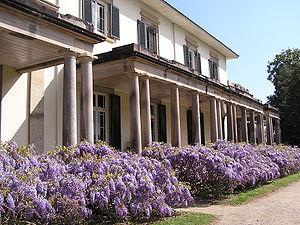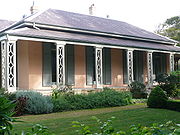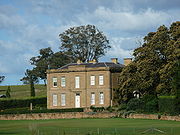
John Verge
Encyclopedia

Life and career
John Verge was born in ChristchurchChristchurch, Dorset
Christchurch is a borough and town in the county of Dorset on the south coast of England. The town adjoins Bournemouth in the west and the New Forest lies to the east. Historically in Hampshire, it joined Dorset with the reorganisation of local government in 1974 and is the most easterly borough in...
, Hampshire
Hampshire
Hampshire is a county on the southern coast of England in the United Kingdom. The county town of Hampshire is Winchester, a historic cathedral city that was once the capital of England. Hampshire is notable for housing the original birthplaces of the Royal Navy, British Army, and Royal Air Force...
. Many generations of the Verge family had been bricklayers and stonemasons. Verge married to Catherine Bowles at the age of twenty-two and went to London. From 1804 to 1828, he worked in London
London
London is the capital city of :England and the :United Kingdom, the largest metropolitan area in the United Kingdom, and the largest urban zone in the European Union by most measures. Located on the River Thames, London has been a major settlement for two millennia, its history going back to its...
in the building trade, becoming a man of means. Verge's marriage eventually failed and, in 1828, he migrated to Sydney
Sydney
Sydney is the most populous city in Australia and the state capital of New South Wales. Sydney is located on Australia's south-east coast of the Tasman Sea. As of June 2010, the greater metropolitan area had an approximate population of 4.6 million people...
, Australia
Australia
Australia , officially the Commonwealth of Australia, is a country in the Southern Hemisphere comprising the mainland of the Australian continent, the island of Tasmania, and numerous smaller islands in the Indian and Pacific Oceans. It is the world's sixth-largest country by total area...
with his son George Philip, intending to take up a land grant. The First land grant in 1829, he took up land on the Williams River, south of Dungog, New South Wales
Dungog, New South Wales
Dungog is a country town on the Williams River in the upper Hunter Valley in New South Wales, Australia. Located in the middle of dairy and timber country, it is the centre of the Dungog Shire Local Government Area and at the 2006 census it had a population of 2,102 people. The area includes the...
called Lyndhurst Vale. The second land grant in 1838, he took up land on the Macleay River named Austral Eden. The Having insufficient capital to pursue pastoralism, Verge returned to the building industry between 1830 and 1837, fortuitously at a time when the colonial economy was prospering and designers and builders were in high demand. Between 1830 and 1834 was his maximum architectural activities. He was patronised by many of prominent businessmen and colonists. After 1837, his architectural work was decreasing and restricted. Retiring from architectural practice, he settled at 'Austral Eden', a pastoral property by the Macleay River
Macleay River
The Macleay River is a major river on the Mid North Coast , Australia.The headwaters of the Macleay River rise as the Gara River on the eastern side of the Northern Tablelands near Armidale and Walcha, New South Wales. From here the Chandler River, Styx River and Apsley Rivers are important...
in northern New South Wales. In 1858, Verge married Mary, 50 years old daughter of John Alford at Austral Eden. Verge died on July 9, 1861 at the age of 79 in Austral Eden. He was buried as an Anglican in St. Thomas's burial ground in Port Macquarie.
In the 1830s Verge produced a number of fine houses in Sydney's eastern suburbs
Eastern Suburbs (Sydney)
The Eastern Suburbs is a general term used to describe the metropolitan area directly to the east and south-east of the Sydney central business district in Sydney, New South Wales, Australia. Eastern Suburbs can refer to the suburbs within the local government areas of Woollahra, Waverley, Dover...
, notably several of the 'Villas of Woolloomooloo Hill', the spine of elegant villas largely built by the senior civil servants of the colony on a series of land grants that stretched from Darlinghurst Hill to Potts Point. These villas included Rockwall, built for surveyor John Busby, Tusculum for merchant Alexander Brodie Spark for whom Verge also designed Tempe House, and Goderich Lodge, for Thomas Macquoid. Others including Barham and Rose Bank have been attributed to his hand. Further east he built Rose Bay Lodge for James Holt. To the west of the town he built Lyndhurst, for Dr James Bowman, and Toxteth Park for George Allen, in Glebe
Glebe, New South Wales
Glebe is an inner-city suburb of Sydney. Glebe is located 3 km south-west of the Sydney central business district and is part of the local government area of the City of Sydney, in the Inner West region....
. Verge is also credited with Elizabeth Bay House
Elizabeth Bay House
Elizabeth Bay House is a historic home in the suburb of Elizabeth Bay in Sydney, New South Wales, Australia. Built between 1835 and 1839, Elizabeth Bay House was known as 'the finest house in the colony'. Elizabeth Bay House is a home in the Regency style, originally surrounded by a garden, but...
, built at adjacent Elizabeth Bay for Alexander Macleay
Alexander Macleay
Hon. Alexander Macleay MLC FLS FRS was a leading member of the Linnean Society and a fellow of the Royal Society.Macleay was born on Ross-shire, Scotland, eldest son of William Macleay, provost of Wick...
, the Colonial Secretary
Chief Secretary
The Chief Secretary is the title of a senior civil servant in members of the Commonwealth of Nations, and, historically, in the British Empire. Prior to the dissolution of the colonies, the Chief Secretary was the second most important official in a colony of the British Empire after the...
. It is theorised that Verge largely worked on a plan provided by Macleay, as his business ledger does not denote amounts that would reflect a full commission. John Bibb, an accomplished draftsman employed by Verge, also worked on the project and James Hume from Scotland supervised the building. The relative contributions of Verge, Bibb and Hume are unknown. The house's beautiful oval saloon, with its geometric stair and domed lantern, is likely the most celebrated interior in early Australian architecture.
Verge's work was not confined to Sydney. 'Bedervale
Bedervale
Bedervale in Braidwood, NSW is a grand colonial homestead listed as a building of historical significance by the Heritage Council. The house was designed by John Verge, a very well known Australian architect, and was completed in 1842....
' homestead, near Braidwood
Braidwood, New South Wales
Braidwood is a town in the Southern Tablelands of New South Wales, Australia, in Palerang Shire. It is located on the busy Kings Highway linking Canberra to Batemans Bay on the coast. It is about 200 kilometres south west of Sydney and about 60 kilometres inland from the coast...
, built in 1842, was designed by Verge. Aberglasslyn, built for George Hobler near Maitland, NSW, has been attributed to Verge. Like Elizabeth Bay House it never received its intended colonnade, the victim of the crippling colonial depression of the 1840s. Wyoming, 1837, is in the suburb of that name north of Gosford. The house he built for himself at Austral Eden was unfortunately destroyed by flood in 1864, three years after Verge's death, and no known sketches survive. Most of his papers were also lost in the flood.
Verge's best known work is Camden Park House
Camden Park, New South Wales
Camden Park is an outer suburb of Sydney, New South Wales, Australia. It was named after John Macarthur's estate "Camden Park". While most of the suburb is farmland in Wollondilly Shire, the northern part of Camden Park has recently undergone suburban development as an extension of the suburb of...
, built south west of Sydney for John Macarthur
John Macarthur (wool pioneer)
John Macarthur was a British army officer, entrepreneur, politician, architect and pioneer of settlement in Australia. Macarthur is recognised as the pioneer of the wool industry that was to boom in Australia in the early 19th century and become a trademark of the nation...
, the wool pioneer and successful colonial businessman. As Macarthur was debilitated towards the end of his life with mental illness his son William seems to have administered much of the building, and is named in Verge's ledger rather than his father. This has caused confusion with some architectural historians as to the actual client.
Main Projects
- Camden Park, Menangle (1835)
Camden Park House is completed on 1835, a year after John Macarthur, the client death. This house is still occupied by the Macarthur family and become one of the great mansions of Australia. The style of this house is Palladian style with central two storey block, one storey wings and extensions at each side. The façade is giving a colonial elegancy sense of looking, where there are white stucco walls, stone porch and window trimming that results a visual excellency of feeling. This colonial house’s floor level is very near to ground level, which gives an air of intimacy and also the overhanging roof has a secret gutter that avoid the ugly looking gutter which usually put it in the front façade of the wall.
- Denham Court, Ingleburn (1832)
Denham Court which is located in the local government areas of the City of Campbelltown and City of Liverpool placed on south west of the Sydney Central Business District. Originally, this building was a single storey house but around 1832 to 1833, Captain Richard Brooks as an architect was enlarging this house by adding two storey wings with two flanking bow-fronted one storey room. This court is regency influenced with trim lines, stucco walls, and the simple shallowly recessed panels projecting porch. Denham Court’s room is 14 feet high with a geometrical stair along the west wall of the house and also there is a large living hall that extending across the width of the house between the bows fronted. The floor in this house is paved with flagstones diagonally with 18 inches square each. Moreover, in the west of this court, there is a Denham Court chapel, which is a mimic of the church at Denham in England. Those churches were designed by John Verge as well with the style of it is Gothic, where mostly this style is taking over the style of every church.
- Elizabeth Bay House (1835–1838)
Elizabeth Bay House, which is a historic home, is located in the suburb of Elizabeth Bay in Sydney, New South Wales, and Australia. It is built between 1835 and 1839. It was known as ‘the finest house in the colony’ as well as a home in the Regency style, originally surrounded by a 54-acre garden, but now situated within a densely populated inner city suburb. It shows Verge at his best and worst as a designer. The main elevation is a simple Regency front, whilst the sides, less ambitious but perhaps more pleasing, have large curved bays, running through the two floors.The general impression given by the design is of quietness and good taste, the severely stuccoed walls being relieved only by the somewhat stiff mouldings run in the plaster work and the elaboration of the entrance. The rear of the house is unstudied and lacks the neatness of the other elevations. The interior has some splendid rooms, the stair hall being one of the finest and perhaps the best, of such things in Australian Colonial architecture. Elliptical on plan, the stair and its upper landings sweep completely round the curved walls. The French windows on the northern front give beautiful light and superb views to main apartment. Verge seems to tire and falter when trying to coordinated all the parts into a whole.
- Rockwall House, Potts Point (1831–1837)
Rockwall House, which is still well-known, is located at Rockwall Crescent that is the well-preserved Regency house that Verge designed for John Bushby. It is quite close to Tusculum. The Rockwall House shows Verge in his most restrained and pleasing mood, although the columned porch seems to overpower the flanking verandas in scale.
- St Scholastica’s College(1831–1900)
St Scholastica’s College, which formerly was Toxteth Park George Allen Estate, is located in Avenue Road Glebe, built in 1831. Toxteth Park was built for George Allen (1800–77). It was a rectangular two-story block with single-story wings, s a stone-flagged veranda on two sides, with the kitchen and servants’ quarters behind. The style of St Scholastica’s College is original structure Old Colonial Georgia (still visible), Second story and tower Victorian Italianate added in the 1870s. Handsome Inter-War Romanesque chapel added in the twenties. It is made of brick. Moreover it was originally House, then convent and Education.
Partial List of Works
The following Verge buildings are listed on the Register of the National EstateRegister of the National Estate
The Register of the National Estate is a listing of natural and cultural heritage places in Australia. The listing was initially compiled between 1976 and 2003 by the Australian Heritage Commission. The register is now maintained by the Australian Heritage Council...
, excepting Toxteth Park, Rose Bay Cottage and Leitrim.


- St Paul's Church, Cobbity, circa 1840
- Camden Park, Menangle, 1835
- Extensions to Denham Court, Ingleburn, 1832, and chapel, 1838
- Lyndhurst, Glebe, Sydney, 1835
- Church of the Holy Innocents, Rossmore, circa 1848, possibly by Verge and Bibb
- Extensions, coachhouse and stables to Elizabeth Farm, Parramatta, 1830s
- Tempe House, Arncliffe, Sydney, 1836
- Barham, Darlinghurst, Sydney, 1833 (now Sydney Church of England Girls Grammar School)
- Elizabeth Bay House, Elizabeth Bay, Sydney, 1835–38
- Vestries and eastern porches of St James's Church, Sydney, 1834
- Brownlow Hill, Cobbity, alterations of 1834 attributed to Verge
- BedervaleBedervaleBedervale in Braidwood, NSW is a grand colonial homestead listed as a building of historical significance by the Heritage Council. The house was designed by John Verge, a very well known Australian architect, and was completed in 1842....
, Braidwood, 1836 - Christ Church, Bong Bong, 1845
- Tomago House, Raymond Terrace, 1843, attributed to Verge
- Rockwall House, Potts Point, Sydney, 1831–37
- Aberglasslyn House, Aberglasslyn, Maitland, circa 1840
- Toxteth Park, GlebeSt Scholastica's (Toxteth Park), Glebe, SydneyToxteth Park is an historic house that now houses St Scholastica's College, Glebe in Sydney, New South Wales. It was built in 1829 by the Australian architect John Verge and is listed by the New South Wales Heritage Council as a building of historical significance...
, Sydney, 1831, State Heritage listing (now St Scholastica's College) - Rose Bay Cottage, Rose Bay, Sydney, 1834, State Heritage listing
- Lietrim (renamed Pine Villa in 1843), Newtown, Sydney, 1833

